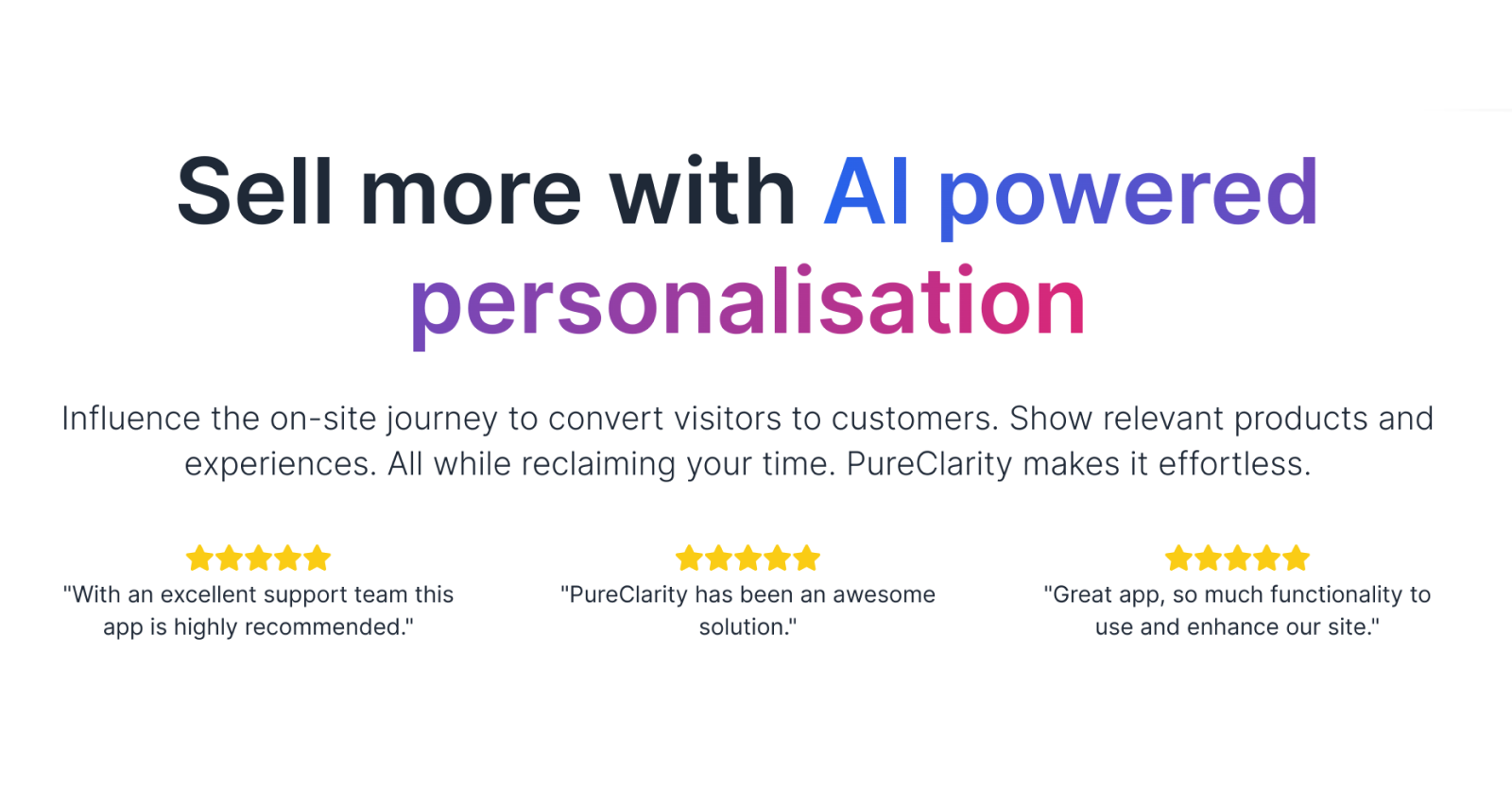
PureClarity AI: Complete Buyer's Guide
Accessible AI-powered personalization platform
PureClarity AI positions itself as an accessible AI-powered personalization platform designed specifically for small to mid-market ecommerce businesses seeking immediate revenue growth through automated product recommendations and behavioral targeting[37][38][45].
Market Position & Maturity
Market Standing
PureClarity AI occupies a strategic middle-market position between basic rule-based bundling tools and enterprise AI platforms, targeting the growing segment of SMB retailers seeking sophisticated personalization without enterprise-level complexity[40][45][50].
Company Maturity
Company maturity indicators show mixed signals requiring careful assessment. While customer relationships like Prima Coffee suggest stable vendor support and multi-year engagements[48], the platform's customer satisfaction rating of 5.0/5 relies on only four Shopify reviews[50][53], limiting comprehensive maturity evaluation.
Longevity Assessment
Long-term viability assessment requires balanced consideration of strengths and risks. The platform's documented customer success in target segments[45][48][49] and transparent pricing model[41][50] suggest sustainable business fundamentals.
Proof of Capabilities
Customer Evidence
Prima Coffee serves as PureClarity's strongest capability validation, demonstrating 43.9% AOV increase specifically from AI product recommenders, 6.5% overall AOV improvement, and 46% increase in average SKUs per order[45][48]. Buffalo Farm validates PureClarity's email capture and personalization capabilities through 647% surge in newsletter sign-ups via targeted pop-ups and 16.7% AOV boost from AI recommendations[49][54]. Engweld provides industrial sector validation, reporting significant revenue growth through AI-driven recommenders deployed across homepage, product pages, and basket pages[54].
Quantified Outcomes
Performance benchmarking against industry standards shows PureClarity exceeding typical results. The documented customer outcomes of 16.7% to 43.9% AOV increases[45][48][49] significantly outperform industry benchmarks of 8-12% conversion lift from static bundles[37][53].
Market Validation
Market validation comes primarily through customer outcomes rather than comprehensive market share data. The platform demonstrates proven effectiveness in specialty retail environments, with documented success spanning specialty foods (Buffalo Farm), beverages (Prima Coffee), and industrial supplies (Engweld)[48][49][54].
AI Technology
PureClarity AI's technical foundation centers on real-time behavioral personalization that eliminates the 30-day data training periods required by competitors like Kefi[40][42].
Architecture
The platform integrates three core AI capabilities: behavioral product recommendations, automated customer segmentation, and email capture optimization[37][38][45], though comprehensive technical architecture documentation remains limited in available research.
Primary Competitors
Primary competitive landscape positions PureClarity against enterprise solutions like Monetate ($300+/month)[43][52] and basic rule-based alternatives lacking AI sophistication.
Competitive Advantages
Key competitive advantages center on immediate functionality without data training periods[40][42], contrasting with competitors like Kefi requiring 30-day algorithm training before value delivery.
Market Positioning
Market positioning strategy targets the growing middle market between basic tools and enterprise platforms, though success depends on genuine AI capabilities versus rule-based automation marketed as AI[2][6][13].
Win/Loss Scenarios
Win/loss scenarios favor PureClarity for SMB retailers prioritizing quick deployment and transparent pricing over comprehensive analytics[40][41][50].
Key Features

Pros & Cons
Use Cases
Integrations
Pricing
Featured In Articles
Comprehensive analysis of Dynamic Bundling for Ecommerce for Ecommerce businesses and online retailers. Expert evaluation of features, pricing, and implementation.
How We Researched This Guide
About This Guide: This comprehensive analysis is based on extensive competitive intelligence and real-world implementation data from leading AI vendors. StayModern updates this guide quarterly to reflect market developments and vendor performance changes.
54+ verified sources per analysis including official documentation, customer reviews, analyst reports, and industry publications.
- • Vendor documentation & whitepapers
- • Customer testimonials & case studies
- • Third-party analyst assessments
- • Industry benchmarking reports
Standardized assessment framework across 8 key dimensions for objective comparison.
- • Technology capabilities & architecture
- • Market position & customer evidence
- • Implementation experience & support
- • Pricing value & competitive position
Research is refreshed every 90 days to capture market changes and new vendor capabilities.
- • New product releases & features
- • Market positioning changes
- • Customer feedback integration
- • Competitive landscape shifts
Every claim is source-linked with direct citations to original materials for verification.
- • Clickable citation links
- • Original source attribution
- • Date stamps for currency
- • Quality score validation
Analysis follows systematic research protocols with consistent evaluation frameworks.
- • Standardized assessment criteria
- • Multi-source verification process
- • Consistent evaluation methodology
- • Quality assurance protocols
Buyer-focused analysis with transparent methodology and factual accuracy commitment.
- • Objective comparative analysis
- • Transparent research methodology
- • Factual accuracy commitment
- • Continuous quality improvement
Quality Commitment: If you find any inaccuracies in our analysis on this page, please contact us at research@staymodern.ai. We're committed to maintaining the highest standards of research integrity and will investigate and correct any issues promptly.